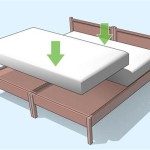When Can I Move My Child To A Toddler Bed?
Transitioning a child from a crib to a toddler bed is a significant milestone, marking a step towards greater independence. However, determining the right time for this transition can be challenging for parents. There isn't a universally applicable age, as each child develops at their own pace. Instead of focusing solely on age, parents should consider several developmental and behavioral cues.
One of the most obvious signs is when the child begins climbing out of the crib. This behavior often emerges between 18 months and 3 years old. A child who successfully climbs out poses a safety risk, as falls can lead to injuries. Even if the child hasn't successfully climbed out, repeated attempts indicate a growing desire for more freedom and suggest the crib is no longer a suitable sleep environment.
Physical development also plays a crucial role. While height and weight are not the primary determinants, a child who is significantly larger than the crib's dimensions may feel cramped and uncomfortable. This discomfort can disrupt sleep patterns and make the transition to a toddler bed more appealing for both the child and the parents.
Beyond physical readiness, parents should assess their child's cognitive and emotional maturity. A child ready for a toddler bed typically understands basic instructions and can follow simple routines. This understanding is essential for establishing healthy sleep habits, such as staying in the bed until morning. A child who consistently tests boundaries and resists bedtime routines might not be ready for the increased freedom of a toddler bed.
The child's emotional readiness is equally important. Some children exhibit anxiety about leaving the familiar confines of their crib. Parents should observe for signs of anxiety, such as clinginess, increased fussiness around bedtime, or regression in previously mastered skills, like independent play. If a child displays these anxieties, it might be beneficial to postpone the transition and focus on addressing those concerns first. Introducing the toddler bed gradually, perhaps initially as a daytime play area, can help ease the transition.
Practical considerations also factor into the decision. Major life changes, such as potty training, the arrival of a sibling, or moving to a new home, can be stressful for a child. Introducing a new sleeping arrangement concurrently with these events might overwhelm the child and make the transition more difficult. Ideally, the transition to a toddler bed should occur during a period of relative stability and calm in the child's life.
Preparing the child for the transition can significantly improve the process. Talking about the change positively, reading books about moving to a "big kid bed," and involving the child in choosing bedding can create excitement and reduce apprehension. Maintaining consistent bedtime routines provides a sense of security and helps the child adjust to the new sleeping arrangement.
Safety should be a paramount concern when transitioning a child to a toddler bed. Ensure the room is childproofed by securing furniture to the walls, covering electrical outlets, and removing any potential hazards. Consider using a bed rail to prevent falls, especially if the child is a restless sleeper. A nightlight can provide comfort and reduce fear of the dark, facilitating a smoother transition.
Regression in sleep patterns can occur after the move to a toddler bed. A child might test the newfound freedom by repeatedly getting out of bed, delaying bedtime, or seeking more parental attention during the night. Consistent and firm enforcement of bedtime routines and gentle encouragement to stay in bed can help the child re-establish healthy sleep habits.
Patience is key throughout the process. The transition might take several weeks or even months, and setbacks are normal. Responding to the child's needs with understanding and maintaining a calm and supportive environment will help the child adapt to the change and embrace the independence of sleeping in a toddler bed.
Open communication between parents and caregivers is essential. Sharing observations about the child's sleep patterns and any challenges encountered helps maintain consistency in the approach and ensures everyone is working towards the same goal. Consulting a pediatrician or a child sleep specialist can provide additional guidance and support if needed.
Ultimately, the decision of when to move a child to a toddler bed is a personal one, based on the individual child’s developmental stage, temperament, and family circumstances. By considering these factors and planning carefully, parents can make the transition a positive and successful experience for everyone involved.

How To Move Your Child From Crib Toddler Bed Safely

5 Signs Your Toddler Is Ready To Move A Bed Cafemom Com

Signs Your Toddler Is Ready For A Big Kid Bed Imperfectly Perfect Mama

Ultimate Guide To The Toddler Bed Transition Taking Cara Babies

How Early Can I Move My Toddler To A Big Kid Bed Cando Kiddo

When To Move Your Toddler A Big Kid Bed

10 Best Tips For Transitioning From Crib To Bed Busy Toddler

When And How To Make The Transition From Cot A Toddler Bed Memory Foam Warehouse

Signs Your Child Is Ready For A Toddler Bed Pampers

When Should I Move My Toddler Into A Bed Just Chill Baby Sleep







